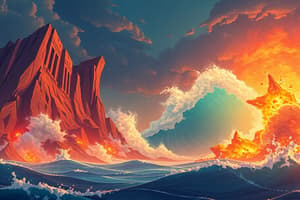Podcast
Questions and Answers
Qual foi o exemplo notável de furacão mencionado no texto?
Qual foi o exemplo notável de furacão mencionado no texto?
- Furacão Irma
- Furacão Sandy
- Furacão Katrina (correct)
- Furacão Maria
Quais são as principais causas de incêndios florestais, de acordo com o texto?
Quais são as principais causas de incêndios florestais, de acordo com o texto?
- Mudanças climáticas
- Raios e tempestades
- Atividades humanas, como fogueiras, cigarros e pirotecnia
- Ambas as alternativas a e b (correct)
Qual foi o exemplo notável de incêndio florestal mencionado no texto?
Qual foi o exemplo notável de incêndio florestal mencionado no texto?
- Os incêndios na Grécia em 2018
- Os incêndios na Amazônia em 2020
- Os incêndios na Austrália em 2019
- Os incêndios na Califórnia em 2018 (correct)
O que pode causar inundações, de acordo com o texto?
O que pode causar inundações, de acordo com o texto?
Qual foi o exemplo notável de inundação mencionado no texto?
Qual foi o exemplo notável de inundação mencionado no texto?
O que é considerado um desastre natural?
O que é considerado um desastre natural?
Qual é a principal causa dos terremotos?
Qual é a principal causa dos terremotos?
Qual das seguintes características NÃO é típica de um furacão?
Qual das seguintes características NÃO é típica de um furacão?
Quais são os principais fatores que determinam a vulnerabilidade da sociedade a desastres naturais?
Quais são os principais fatores que determinam a vulnerabilidade da sociedade a desastres naturais?
Qual foi o terremoto mais mortal na história recente?
Qual foi o terremoto mais mortal na história recente?
Flashcards are hidden until you start studying
Study Notes
Natural Hazards and Disasters
Natural hazards refer to geological, hydrological, atmospheric phenomena that pose potential harm to humans and their environment. These hazards become disasters when they interact with societal vulnerability, resulting in widespread destruction and loss of life. Societal vulnerability is determined by factors like social, political, and economic status, urban planning, and resource distribution. There are four primary types of natural hazards that contribute significantly to disasters: earthquakes, hurricanes, wildfires, and floods.
Earthquakes
Earthquakes are caused by sudden movements in the Earth's surface known as seismicity. These movements release energy waves, called seismic waves, that shake the ground. Depending on the magnitude and location of the quake, the shaking may cause moderate or severe damage to buildings and infrastructure. The deadliest earthquake in recent history was the Great East Japan Quake in 2011, which had a magnitude of 9.0 and led to massive loss of life and property damage.
Hurricanes
Hurricanes are tropical storms characterized by heavy winds, precipitation, and a well-defined center of circulation, known as the eye. They form over warm ocean waters near the equator and move westward until they encounter land. Hurricanes can produce torrential rains, damaging winds, and coastal flooding, leading to extensive property damage and loss of life. One notable example is Hurricane Katrina, which hit New Orleans in 2005, causing widespread devastation and over 1,200 deaths.
Wildfires
Wildfires are often ignited by lightning strikes or human activities such as campfires, cigarettes, or pyrotechnics. They spread rapidly, fueled by vegetation, wind, and temperature conditions. Wildfires can cause extensive damage to forests, wildlife habitats, and communities. One notable instance of this type of disaster was the California wildfire outbreak in 2018, which burned over 150,000 acres and destroyed thousands of homes.
Floods
Floods occur when water levels in rivers, lakes, and oceans exceed their banks or when heavy rainfall causes water to accumulate on land. Floods can have devastating consequences, causing widespread property damage and loss of life. The 2013 flood in Colorado is an example where extensive flooding caused by heavy rains destroyed hundreds of homes and infrastructure.
In conclusion, natural hazards such as earthquakes, hurricanes, wildfires, and floods pose significant threats to society. Their impact depends on the interaction between the physical event itself and the societal vulnerability it encounters. Understanding these risks and taking appropriate measures to mitigate them is crucial for reducing the impacts of disasters and protecting human lives and livelihoods.
Studying That Suits You
Use AI to generate personalized quizzes and flashcards to suit your learning preferences.




